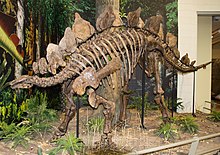Portal:Dinosaurs
IntroductionDinosaurs are a diverse group of reptiles of the clade Dinosauria. They first appeared during the Triassic period, between 243 and 233.23 million years ago (mya), although the exact origin and timing of the evolution of dinosaurs is a subject of active research. They became the dominant terrestrial vertebrates after the Triassic–Jurassic extinction event 201.3 mya and their dominance continued throughout the Jurassic and Cretaceous periods. The fossil record shows that birds are feathered dinosaurs, having evolved from earlier theropods during the Late Jurassic epoch, and are the only dinosaur lineage known to have survived the Cretaceous–Paleogene extinction event approximately 66 mya. Dinosaurs can therefore be divided into avian dinosaurs—birds—and the extinct non-avian dinosaurs, which are all dinosaurs other than birds. Dinosaurs are varied from taxonomic, morphological and ecological standpoints. Birds, at over 11,000 living species, are among the most diverse groups of vertebrates. Using fossil evidence, paleontologists have identified over 900 distinct genera and more than 1,000 different species of non-avian dinosaurs. Dinosaurs are represented on every continent by both extant species (birds) and fossil remains. Through the first half of the 20th century, before birds were recognized as dinosaurs, most of the scientific community believed dinosaurs to have been sluggish and cold-blooded. Most research conducted since the 1970s, however, has indicated that dinosaurs were active animals with elevated metabolisms and numerous adaptations for social interaction. Some were herbivorous, others carnivorous. Evidence suggests that all dinosaurs were egg-laying, and that nest-building was a trait shared by many dinosaurs, both avian and non-avian. (Full article...) Selected article
Edmontosaurus (meaning 'Edmonton [Formation] lizard') is a genus of crestless duck-billed dinosaur. The fossils of this animal have been found in rocks of western North America that date from the late Campanian stage to the end of the Maastrichtian stage of the Cretaceous Period, between 73 and 65.5 million years ago. It was one of the last non-avian dinosaurs, and lived alongside Triceratops and Tyrannosaurus shortly before the Cretaceous–Paleogene extinction event. Edmontosaurus was one of the largest hadrosaurids, measuring up to 13 meters (43 ft) long and weighing around 4.0 metric tons (4.4 short tons). It is known from several well-preserved specimens that include not only bones, but in some cases extensive skin impressions and possible gut contents.
Edmontosaurus has a lengthy and complicated taxonomic history dating to the late 19th century. Various species classified with genera such as Claosaurus, Thespesius, Trachodon, and the well-known but now defunct genus Anatosaurus are now regarded as belonging to Edmontosaurus. The first fossils named Edmontosaurus were discovered in southern Alberta, Canada, in what used to be called the lower Edmonton Formation. The type species, E. regalis, was named by Lawrence Lambe in 1917, although several other species that are now classified in Edmontosaurus were named earlier. The best known of these is E. annectens, originally named by Othniel Charles Marsh in 1892 as Claosaurus annectens and known for many years as Anatosaurus annectens. Edmontosaurus was widely distributed across western North America. The distribution of Edmontosaurus fossils suggests that it preferred coasts and coastal plains. It was an herbivore that could move on both two legs and four. Because it is known from several bone beds, Edmontosaurus is thought to have lived in groups, and may have been migratory as well. The wealth of fossils has allowed researchers to study its paleobiology in detail, including its brain, how it may have fed, and its injuries and pathologies, such as evidence for a tyrannosaur attack on one edmontosaur specimen. (see more...) TopicsSubcategoriesSelected image
Photo credit: User:Llez Did you know...
Things you can do
Featured article candidates
Peer reviews
Articles to be merged
Articles to be split
Related content
Associated WikimediaThe following Wikimedia Foundation sister projects provide more on this subject:
Discover Wikipedia using portals |





























